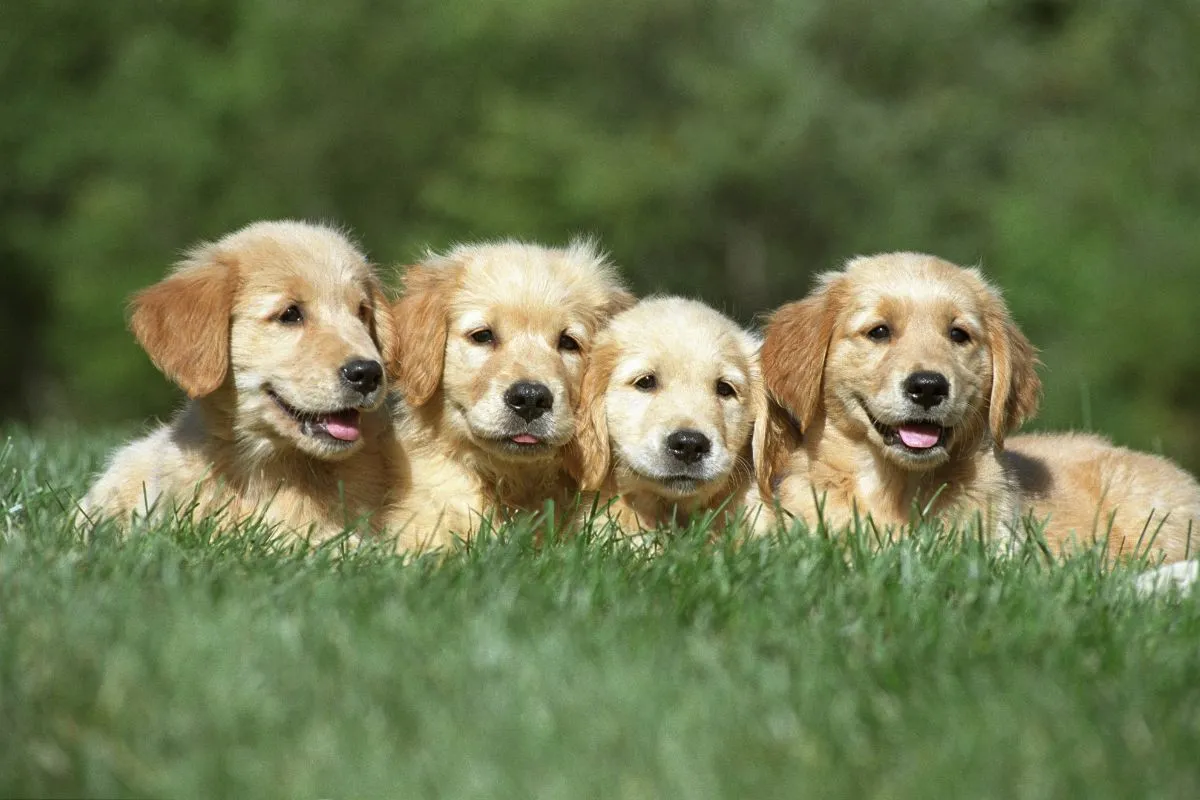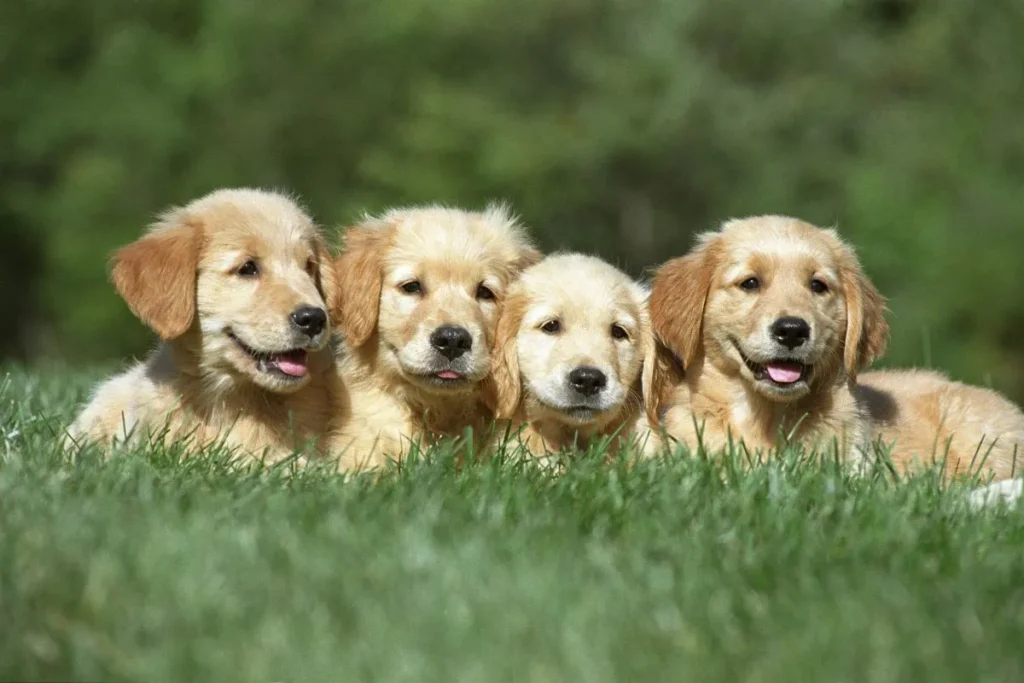Table of Contents
Introduction to Golden Retrievers
Golden Retriever Puppies stand as one of the most beloved dog breeds worldwide, capturing hearts with their friendly demeanor and stunning golden coats. As a family-oriented breed, these dogs have consistently ranked among the most popular choices for households across America and beyond. In this comprehensive guide, we will explore fascinating facts about Golden Retriever puppies and adult dogs alike, delving into their characteristics, care requirements, and the various types available today.
Golden Retrievers originated in Scotland during the mid-19th century, bred specifically by Lord Tweedmouth to create the perfect gundog that could retrieve waterfowl across both land and water. The success of his breeding program resulted in the intelligent, trainable, and water-loving companions we know today. Their gentle temperament makes them excellent family dogs, while their working heritage provides them with boundless energy and a strong desire to please their human companions.
Do Golden Retrievers Shed?
When considering bringing a Golden Retriever puppy into your home, prospective owners often wonder about shedding. The answer is unequivocal: yes, Golden Retrievers shed significantly throughout the year. These dogs possess a double coat consisting of a dense, water-repellent outer layer and a soft, insulating undercoat that helps regulate their body temperature in various conditions.
Golden Retrievers experience two major shedding seasons annually, typically in spring and fall, when they “blow” their coats in preparation for the upcoming season. During these periods, shedding increases dramatically, and daily brushing becomes essential to manage the loose fur. However, even outside these peak shedding times, Golden Retrievers will shed moderately year-round.
To manage shedding effectively, we recommend:
- Brush your Golden Retriever 3-4 times weekly during normal periods and daily during shedding seasons
- Using appropriate tools such as slicker brushes, undercoat rakes, and deshedding tools
- Maintaining proper nutrition for optimal coat health
- Regular bathing with dog-specific shampoos (approximately once every 4-6 weeks)
While shedding cannot be eliminated, consistent grooming significantly reduces the amount of fur found around your home and keeps your Golden Retriever puppy looking its best as it grows into adulthood.
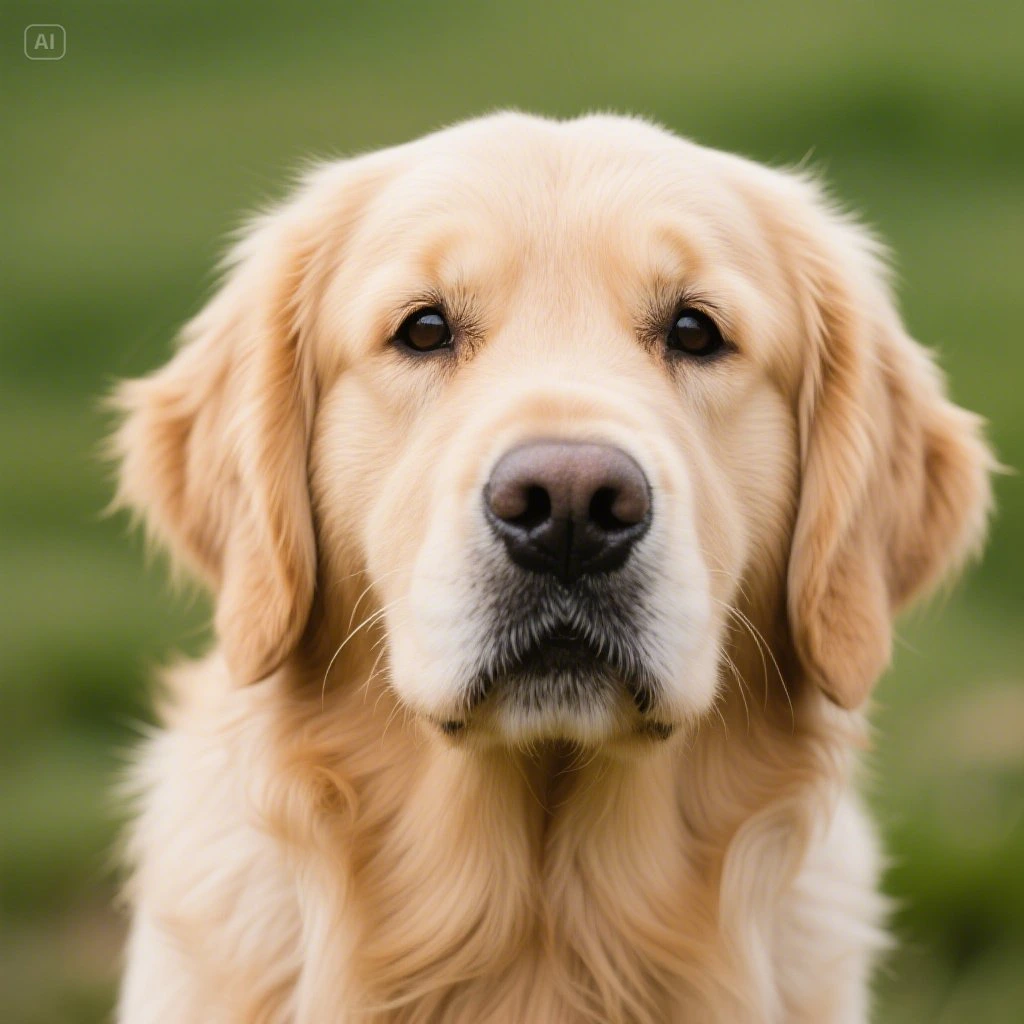
Are Golden Retrievers Smart?
Golden Retrievers rank among the most intelligent dog breeds in the world. According to canine intelligence expert Dr. Stanley Coren, Golden Retrievers stand as the fourth smartest breed in terms of working and obedience intelligence, meaning they typically learn new commands in fewer than five repetitions.
This exceptional intelligence manifests in several ways:
- Quick learning ability: Golden Retriever puppies can begin basic training as early as 8 weeks old and often master fundamental commands rapidly
- Problem-solving skills: They demonstrate a remarkable ability to figure out puzzles and overcome obstacles
- Emotional intelligence: Golden Retrievers excel at reading human emotions and responding appropriately
- Training versatility: Their intelligence allows them to excel in various roles, including service dogs, therapy dogs, search and rescue, and competitive obedience
The intelligence of Golden Retriever puppies makes them highly trainable but also means they require mental stimulation to prevent boredom. Interactive toys, training sessions, and engaging activities help satisfy their cognitive needs and prevent unwanted behaviors that might emerge from understimulation.
Are Golden Retrievers Hypoallergenic?
For allergy sufferers hoping to welcome a Golden Retriever puppy into their home, we must clarify that Golden Retrievers are not hypoallergenic dogs. In fact, they’re quite the opposite. Their abundant shedding and dander production make them challenging companions for those with dog allergies.
Dog allergies are primarily triggered by a protein called Can f 1, which is present in a dog’s saliva, urine, and dander (dead skin cells). When Golden Retrievers shed their fur, these allergens spread throughout the home environment. Their double coat and significant shedding mean more dander circulation compared to single-coated or low-shedding breeds.
While no dog is truly 100% hypoallergenic, several breeds produce fewer allergens than Golden Retrievers. Those with allergies who have their heart set on a Golden Retriever might consider:
- Implementing rigorous cleaning routines with HEPA filters
- Creating dog-free zones within the home, particularly bedrooms
- Using allergen-reducing shampoos when bathing their pet
- Consulting with an allergist before bringing a Golden Retriever puppy home
Despite these measures, individuals with moderate to severe dog allergies may still experience significant symptoms around Golden Retrievers and might be better suited to a breed that produces fewer allergens.
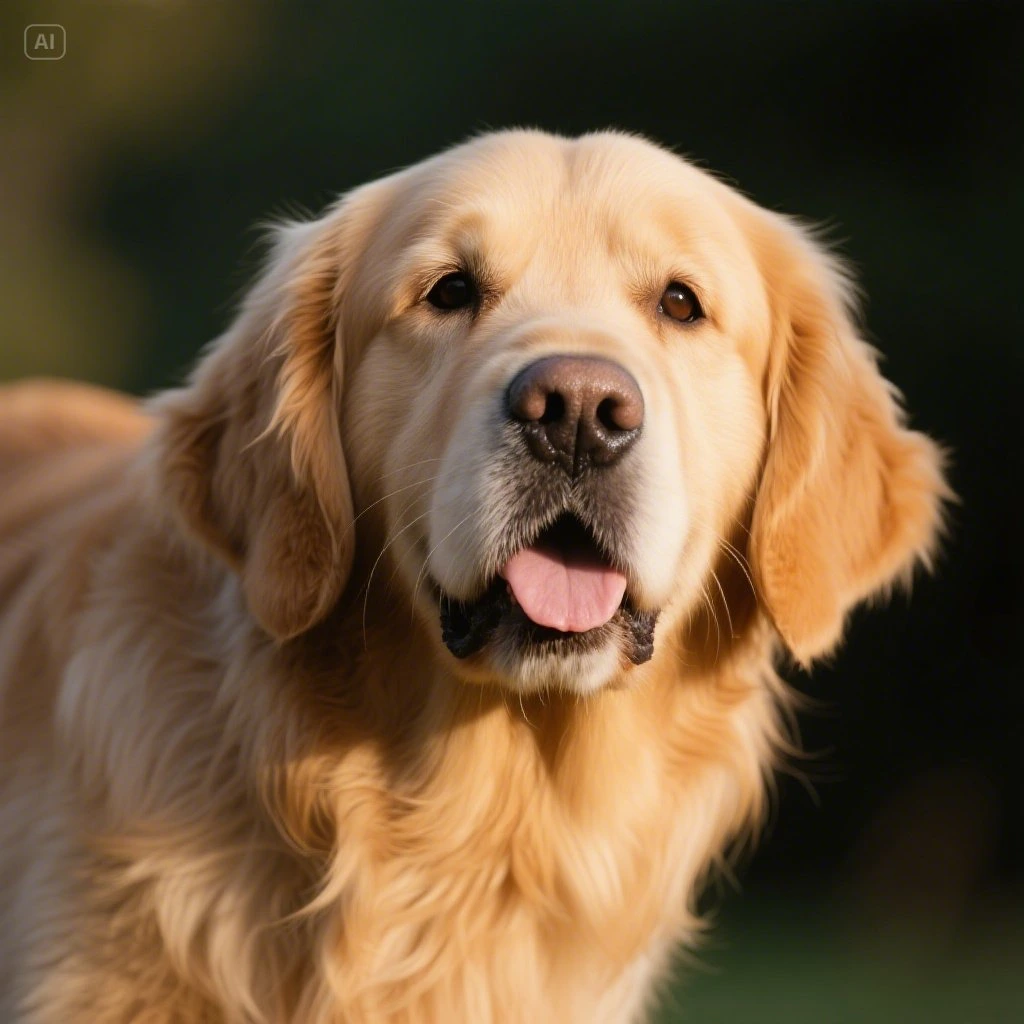
Are Golden Retrievers Aggressive?
Golden Retrievers have earned their reputation as one of the friendliest and most gentle dog breeds available, making them exceptional family pets. Golden Retrievers are not typically aggressive dogs; rather, they are known for their patient, tolerant nature and affinity for human companionship.
The breed standard specifically emphasizes a friendly, reliable, and trustworthy temperament. Well-bred and properly socialized Golden Retriever puppies grow into dogs that typically display:
- Natural affection toward people, including strangers
- Exceptional patience with children
- Good compatibility with other pets
- A desire to please rather than dominate
When aggression does occasionally occur in Golden Retrievers, it usually stems from:
- Inadequate socialization during critical developmental periods
- Fear or anxiety due to traumatic experiences
- Resource guarding behaviors that weren’t properly addressed
- Pain or underlying medical conditions
- Poor breeding practices that didn’t prioritize temperament
To ensure your Golden Retriever puppy develops into a well-adjusted adult, early and ongoing socialization is crucial. Exposing puppies to a variety of people, animals, environments, and situations helps them become confident, stable adults. Positive reinforcement training methods work particularly well with this breed, as harsh corrections can damage their sensitive nature and potentially create fear-based behaviors.
Can Golden Retrievers Be Black?
One of the most common misconceptions about this breed concerns their coloration. Purebred Golden Retrievers cannot be black according to breed standards established by major kennel clubs worldwide. The name “Golden Retriever” directly references their characteristic gold to cream-colored coat, which is a defining feature of the breed.
The acceptable color range for Golden Retrievers, according to the American Kennel Clu,b ranges from light golden to dark golden, but never extends to black. When someone encounters what appears to be a black Golden Retriever puppy, they are likely seeing:
- A Flat-Coated Retriever, which looks similar to Golden Retrievers but comes with a black coat
- A mixed-breed dog with Golden Retriever and black-coated breed ancestry
- A marketing misrepresentation, sometimes called “Rare Black Golden Retrievers,” which is inaccurate terminology
While coat colors can darken as puppies mature, a true Golden Retriever puppy will never develop a black coat. Their color ranges include:
- Light golden (cream to light gold)
- Medium golden (the “classic” golden color)
- Dark golden (rich, deep gold, sometimes with reddish tones)
Any breeder claiming to offer black Golden Retrievers is either misinformed about breed standards or deliberately misleading potential buyers.
English Cream Golden Retriever
The English Cream Golden Retriever has gained popularity in recent years, sometimes marketed as “rare” or “platinum” retrievers. Despite these marketing terms, these dogs are purebred Golden Retrievers that simply align with British breed standards rather than American ones.
English Cream Golden Retrievers typically feature:
- A lighter coat color ranging from cream to very light gold
- A slightly blockier head and stronger build
- Often a straighter topline compared to American Golden Retrievers
- Slightly different facial features with a more pronounced stop
While many assume English Cream Golden Retrievers differ fundamentally from other Golden Retrievers, they are the same breed with slight variations due to different breeding standards across countries. Golden Retriever puppies with this cream coloration often come with premium prices due to their perceived uniqueness, though they share the same temperament and care requirements as their more golden counterparts.
Health-wise, some proponents claim English Cream Golden Retrievers have lower cancer rates, though scientific evidence supporting this claim remains limited. When considering an English Cream variant, we recommend focusing on the breeder’s health testing practices rather than coat color as an indicator of health potential.
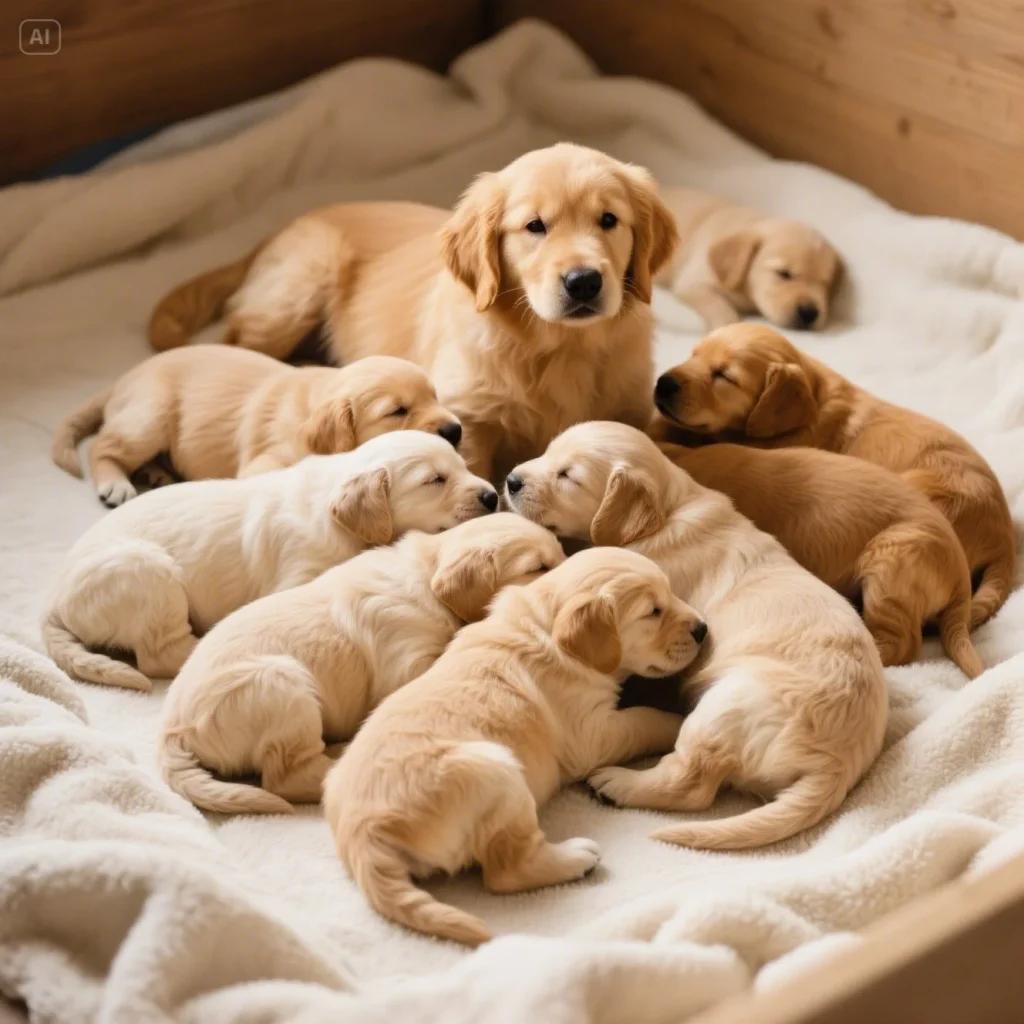
Mini Golden Retriever
The Mini Golden Retriever isn’t an officially recognized breed but rather a designer dog created by crossing Golden Retrievers with smaller breeds to achieve a dog with Golden Retriever characteristics in a more compact size. These dogs typically weigh between 20-45 pounds, significantly smaller than standard Golden Retrievers that weigh 55-75 pounds.
Common breeds used to create Miniature Golden Retrievers include:
- Cocker Spaniels
- Cavalier King Charles Spaniels
- Poodles (creating what’s sometimes called a “Comfort Retriever”)
These smaller Golden Retriever puppy alternatives often appeal to those with limited space or those who want the Golden Retriever temperament in a more manageable size. However, prospective owners should understand that these dogs may inherit characteristics from both parent breeds, making temperament and care requirements somewhat less predictable than purebred Golden Retrievers.
When considering a Mini Golden Retriever, research the specific mix being offered and the reputation of the breeder. Since these aren’t purebred dogs, they aren’t subject to established breed standards, making quality control more challenging.
Golden Retriever Price
The cost of Golden Retriever puppies varies widely depending on several factors, including geographical location, lineage, breeder reputation, and coat color. On average, prospective owners can expect to pay between $1,000 to $3,500 for a well-bred puppy from health-tested parents.
Factors that influence Golden Retriever puppy prices include:
- Pedigree and lineage: Puppies from champion bloodlines or with exceptional pedigrees command higher prices
- Health testing: Responsible breeders who conduct comprehensive health screening invest more in their breeding program
- Coat color: Particularly light or dark specimens sometimes come with premium pricing
- Geographic location: Prices tend to be higher in urban areas and regions where the cost of living is elevated
- Breeder reputation: Established breeders with proven track records typically charge more than newcomers
Beyond the initial purchase price, prospective owners should budget for substantial ongoing costs. During the first year of ownership, expenses including veterinary care, spaying/neutering, training, food, supplies, and preventative medications can easily add $1,500-3,000 to the initial investment.
We strongly advise against seeking bargain-priced Golden Retriever puppies, as extremely low prices often indicate corner-cutting in health testing, proper veterinary care, or ethical breeding practices. The long-term costs of potential genetic health issues far outweigh any initial savings.
Red Golden Retriever
The Red Golden Retriever represents one of the darker variations within the acceptable color spectrum for the breed. These dogs display a rich, mahogany or deep coppery coat that appears distinctly darker than the typical golden shade most associate with the breed.
Despite their striking coloration, Red Golden Retrievers are not a separate breed or variety—they are purebred Golden Retrievers whose genetics produce a darker coat pigmentation. This coloration falls within official breed standards, though it appears less commonly than medium gold coats.
Golden Retriever puppies with red coloration often darken as they mature, with their adult shade becoming most apparent after they lose their puppy coat. The intensity of their color typically reaches its peak when they’re fully mature at around 2-3 years of age.
Some considerations specific to Red Golden Retrievers include:
- Their darker coats may show less visible dirt and staining
- They sometimes (though not always) have correspondingly darker eyes
- The rich red coloration tends to hold up well against sun fading
- They require the same grooming regimen as other Golden Retrievers
While some breeders specialize in producing this color variant and may charge premium prices, Red Golden Retrievers share identical temperament, health considerations, and care requirements as their lighter-colored counterparts.
White Golden Retriever
The term White Golden Retriever typically refers to extremely light-colored Golden Retrievers, though truly white specimens don’t exist within breed standards. What many people call “white” Golden Retrievers are actually very pale cream-colored dogs, most commonly seen in the English-type Golden Retrievers.
According to major kennel club standards, Golden Retrievers should display some degree of gold coloration, even if extremely light. Dogs marketed as White Golden Retriever puppies are typically:
- Very light cream-colored Golden Retrievers
- English-type Golden Retrievers with particularly pale coloration
- Sometimes mislabeled for marketing purposes
The extremely light coat color comes with several practical considerations:
- Shows dirt, mud, and stains more visibly than darker golden coats
- May require more frequent bathing to maintain their pristine appearance
- Often has slightly different texture compared to deeper golden coats
- May be more prone to visible tear staining around the eyes
When seeking an extremely light-colored Golden Retriever, we recommend using the term “cream” rather than “white” when communicating with reputable breeders, as this more accurately reflects breed standards and avoids confusion with truly white dog breeds.
German Shepherd Golden Retriever Mix
The German Shepherd Golden Retriever Mix, sometimes called a Golden Shepherd, represents one of the more popular designer dog crosses, combining two highly intelligent and capable working breeds. This mix brings together the loyalty and protective nature of the German Shepherd with the friendly, outgoing temperament of the Golden Retriever.
These mixed-breed dogs typically weigh between 60-85 pounds when fully grown and feature a blend of physical characteristics from both parent breeds. While no mixed breed produces completely predictable results, Golden Shepherds often display:
- A coat length somewhere between the German Shepherd’s medium coat and the Golden Retriever’s longer coat
- Coloration ranging from tan to golden, frequently with some black markings
- Erect or semi-erect ears, often starting floppy like a Golden Retriever puppy but becoming more upright with age
- Athletic builds with strong muscles and good endurance
Temperamentally, these dogs often inherit the Golden Retriever’s friendliness tempered with some of the German Shepherd’s natural protective instincts. They typically make excellent family dogs with proper training and socialization, though they require substantial exercise and mental stimulation to prevent boredom-related behaviors.
Prospective owners should note that, as with any mixed breed, health concerns from both parent breeds may appear in these dogs, including hip dysplasia, which affects both German Shepherds and Golden Retrievers.
Miniature Golden Retriever
The Miniature Golden Retriever represents a relatively new designer dog trend aimed at creating a smaller version of the beloved Golden Retriever. Unlike the standard Golden Retriever that typically weighs between 55-75 pounds, these miniature versions usually weigh between 20-45 pounds at maturity.
True Miniature Golden Retrievers are created through crossbreeding programs rather than through breeding unusually small purebred Golden Retrievers (sometimes unethically marketed as “teacup” retrievers). The most common breeds used to create these smaller versions include:
- Cocker Spaniels combined with Golden Retrievers
- Poodles mixed with Golden Retrievers (sometimes called “Comfort Retrievers”)
- Cavalier King Charles Spaniels crossed with Golden Retrievers
Golden Retriever puppy enthusiasts who choose these miniature versions often do so for practical reasons, including:
- More manageable size for apartment or small home living
- Reduced exercise requirements compared to standard Golden Retrievers
- Lower food costs and smaller waste production
- Easier handling for elderly owners or those with physical limitations
While these dogs often inherit many of the beloved Golden Retriever traits, their mixed heritage means they may display characteristics from their other parent breed as well. Prospective owners should research all parent breeds involved in their particular mix to understand potential temperament, health concerns, and care requirements fully.
Golden Retriever Names
Choosing the perfect name for your Golden Retriever puppy represents an important decision that will shape your communication with your pet for years to come. Golden Retrievers, with their friendly, outgoing personalities and golden coats, inspire a wide range of naming options that celebrate their distinctive characteristics.
Popular name categories for Golden Retrievers include:
Color-Inspired Names: Highlighting their beautiful golden coats
- Amber, Honey, Sunny, Goldie, Blaze, Copper, Ginger
Nature-Themed Names: Reflecting their outdoor heritage
- River, Aspen, Oak, Canyon, Maple, Sierra, Forest, Willow
Happy/Positive Names: Complementing their cheerful disposition
- Joy, Happy, Buddy, Cheerio, Bliss, Merry, Jubilee
Classic Dog Names: Timeless options that suit the breed well
- Bailey, Max, Charlie, Sadie, Cooper, Bella, Lucy, Molly
Scottish Names: Honoring their Scottish heritage
- Angus, Fergus, Wallace, Isla, Skye, Loch, Fiona
When selecting a name for your Golden Retriever, we recommend considering:
- Two-syllable names that are easily recognizable to your dog
- Names that don’t sound similar to common commands (avoid names like “Kit” that sound like “sit”)
- Names you feel comfortable calling out loudly at the dog park
- A name that can grow with your puppy into adulthood
The perfect name often becomes apparent as you spend time with your new Golden Retriever puppy and observe their unique personality traits and behaviors. Many owners find that waiting a few days after bringing their puppy home helps them choose a name that truly fits their new companion.
Conclusion
Golden Retrievers continue to rank among the most beloved dog breeds worldwide for good reason. Their friendly temperament, intelligence, and adaptability make them excellent companions for families, individuals, and working environments alike. While they do require significant exercise, regular grooming to manage shedding, and proper training, the rewards of Golden Retriever ownership far outweigh these responsibilities for devoted dog lovers.
Whether you’re drawn to the classic golden coat, the cream English variety, or even considering a mix or miniature version, understanding the breed’s characteristics helps ensure you make an informed decision when welcoming a Golden Retriever puppy into your home. With proper care, training, and love, these remarkable dogs provide years of loyal companionship and joy to fortunate owners worldwide.
